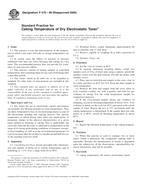We need your consent to use the individual data so that you can see information about your interests, among other things. Click "OK" to give your consent.
ASTM F470-89(2009)
Standard Practice for Caking Temperature of Dry Electrostatic Toner (Withdrawn 2017)
Automatically translated name:
Standard Practice for Caking Temperature of Dry Electrostatic Toner
STANDARD published on 1.2.2009
The information about the standard:
Designation standards: ASTM F470-89(2009)
Note: WITHDRAWN
Publication date standards: 1.2.2009
SKU: NS-55441
The number of pages: 2
Approximate weight : 6 g (0.01 lbs)
Country: American technical standard
Category: Technical standards ASTM
The category - similar standards:
Annotation of standard text ASTM F470-89(2009) :
Keywords:
caking temperature, dry toners, electrostatic toners, Caking temperature, Electrostatic copier, ICS Number Code 37.100.20 (Materials for graphic technology)
Additional information
| Significance and Use |
|
Dry toners for use in electrostatic copiers and printers are normally free-flowing powders at room temperatures. They are often formulated to fuse at elevated temperatures as part of the electrostatic printing and copying process. The specific temperature at which fusing takes place has implications of premature change in the physical characteristics of a given toner, defined as blocking or caking. This is undesirable, but can result when the dry toner is subjected to temperatures in the range of its fusing point during conditions of transport, storage, or local handling; as well as to the environmental parameters in a given location after the product is introduced and held for use in the machine reservoir itself. |
| 1. Scope |
|
1.1 This practice covers the determination of the temperature at which a dry toner will cake as storage temperatures are raised. 1.2 In certain cases the effects of pressure or pressure combined with heat can cause blocking and caking of a dry toner. This recommended practice does not provide for evaluation of such pressure effects. 1.3 This practice consists of testing samples at controlled temperatures and evaluating them for any sign of blocking after a specified period. 1.4 The values stated in SI units are to be regarded as standard. No other units of measurement are included in this standard. 1.5 This standard does not purport to address all of the safety concerns, if any, associated with its use. It is the responsibility of the user of this standard to establish appropriate safety and health practices and determine the applicability of regulatory limitations prior to use. |
We recommend:
Technical standards updating
Do you want to make sure you use only the valid technical standards?
We can offer you a solution which will provide you a monthly overview concerning the updating of standards which you use.
Would you like to know more? Look at this page.




 Cookies
Cookies
